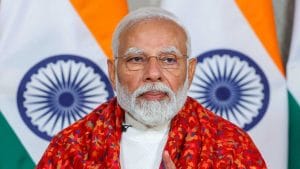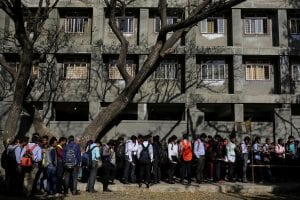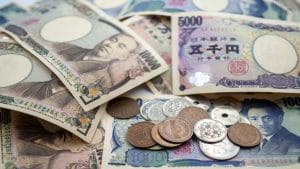India opens some doors for onion exports after nearly five months of ban
Summary
The centre also allowed export of 2,000 million tonne of white onion cultivated via Mundra Port, Pipavav Port and Nhava Sheva/JNPT Port.
After nearly five months of export ban, the government on April 26, has allowed export of 99,150 million tonne of onions, mainly sourced from Maharashtra, to six neighbouring countries.
In an official statement, the Ministry of Consumer Affairs, Food & Public Distribution said the government has “allowed export of 99,150 tonne of onion to six neighbouring countries of Bangladesh, UAE, Bhutan, Bahrain, Mauritius and Sri Lanka”.
On December 8, 2023, the government banned export of onions to ensure adequate domestic availability against the backdrop of estimated lower Kharif and Rabi crops in 2023-24 as compared to previous year and increase demand in international market.
The National Cooperative Exports Limited (NCEL), the agency for the export of onion to these countries, sourced the domestic onions to be exported through e-platform at L1 prices, the statement said. NCEL has supplied to the agency or agencies nominated by the government of the destination country at the negotiated rate on a 100% advance payment basis.
The offer rate of NCEL to the buyers takes into account the prevailing prices in the destination market and also international and domestic markets. The quota allocated for export to the six countries are being supplied as per requisition made by the destination country.
As the largest producer of onion in the country, Maharashtra is the major supplier of onions sourced by NCEL for export, the statement said.
The procurement target for onion buffer out of Rabi crop 2024 under the Price Stabilisation Fund (PSF) of the Department of Consumer Affairs has been fixed at 5 lakh tonne this year.
The Central agencies, like NCCF and NAFED are tying up local agencies like FPOs/FPCs/PACs to support the procurement, storage and farmers registration to begin the procurement of any store-worthy onion.
A high-level team of the Department of Consumer Affairs, NCCF and NAFED visited Nashik and Ahmednagar districts of Maharashtra from April 11-13, 2024, to create awareness among the farmers, FPOs/FPCs and PACs about the procurement of 5 lakh tonne of onion for buffer stock.
To reduce the storage loss of onions, the department has decided to enhance the quantum of stocks to be irradiated and cold stored from 1,200 tonne last year to over 5,000 tonne this year, with technical support from BARC, Mumbai.
The pilot of onion irradiation and cold storage taken up last year has been found to have resulted in the reduction of storage loss to less than 10%, the statement said.
The Centre on Thursday April 25 also allowed exports of 2,000 million tonne of white onion cultivated from Mundra Port, Pipavav Port and Nhava Sheva/JNPT Port. Traders from any state can export their onions via these three Gujarat Ports.
However, CNBC-TV18’s Santia Gora reports that Maharashtra traders believe the decision is partial and is taken to favour Gujarat traders.
According to Maharashtra traders, exporters will need an NOC from Gujarat’s Horticulture Commissioner and even if Maharashtra traders would try and export, Gujarat exporters will reach the ports first, and the 2000 million tonne limit will get over.
Exporting onions via Gujarat Ports will also be logistically and monetarily unviable for traders from Maharashtra and other states.
Traders believe that taking a container from states like Maharashtra and others to Gujarat will increase overall cost by multiple folds. It will also increase the time required to complete the export procedure by at least two days.
Amid rising resentment among traders, the Mahayuti government in Maharashtra has been batting for revoking the ban.
Reacting to exports of white onions via the three ports, Aaditya Thackeray in a post on social media platform X, questioned why is the Centre anti-Maharashtra.
“Once again, Maharashtra faces injustice from the BJP, only to benefit Gujarat. Why can’t both states be given equal treatment?” he said.
Once again, Maharashtra faces injustice from the bjp, only to benefit Gujarat.
Why can’t both states be given equal treatment?
Why is bjp so anti Maharashtra? https://t.co/uPI02mh9Kd
— Aaditya Thackeray (@AUThackeray) April 27, 2024
In March, the Union Agriculture Ministry released the data for onion production. As per the data, onion production in 2023-24 (First Advance Estimates) is expected to be around 254.73 lakh tonnes compared to around 302.08 lakh tonnes last year.
This is due to a decrease of 34.31 lakh tonne output in Maharashtra, 9.95 lakh tonne in Karnataka, 3.54 lakh tonne in Andhra Pradesh and 3.12 lakh tonne in Rajasthan, the data showed.

Elon Musk forms several ‘X Holdings’ companies to fund potential Twitter buyout
3 Mins Read
Thursday’s filing dispelled some doubts, though Musk still has work to do. He and his advisers will spend the coming days vetting potential investors for the equity portion of his offer, according to people familiar with the matter









 Listen to the Article
Listen to the Article  Daily Newsletter
Daily Newsletter













